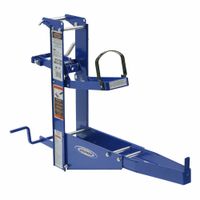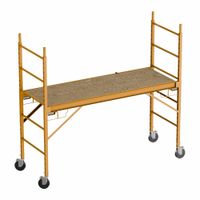Call +(254) 703 030 000 / 751 483 999 / 721 704 777
- Home
- Material Handling
- Ladders Platforms Personnel Lifts
- Scaffolding
.....Read More
Frequently Asked Questions
What is scaffolding and why is it used?
Scaffolding is a temporary structure used in construction and maintenance to provide support and access to workers and materials. It is typically made of metal or wood and consists of platforms, frames, and braces. Scaffolding is essential for tasks that require working at heights, such as building construction, painting, window cleaning, and repairs.
The primary purpose of scaffolding is to ensure the safety of workers by providing a stable and secure platform from which they can perform their tasks. It allows workers to access hard-to-reach areas safely and efficiently, reducing the risk of falls and accidents. Scaffolding also facilitates the transportation of materials and tools to elevated work areas, enhancing productivity and efficiency.
Scaffolding is used for several reasons:
1. **Safety**: It minimizes the risk of falls and injuries by providing a stable work platform and guardrails.
2. **Accessibility**: It enables workers to reach high or awkward areas that would otherwise be inaccessible.
3. **Efficiency**: It allows multiple workers to perform tasks simultaneously, speeding up the construction or maintenance process.
4. **Versatility**: Scaffolding can be customized and adjusted to fit various building shapes and sizes, making it suitable for a wide range of projects.
5. **Support**: It provides structural support for workers and materials, ensuring stability during construction or repair work.
Overall, scaffolding is a critical component in construction and maintenance projects, ensuring safety, accessibility, and efficiency.
How do you ensure scaffolding safety?
To ensure scaffolding safety, follow these key practices:
1. **Design and Planning**: Engage qualified professionals to design scaffolding systems that meet the specific requirements of the project. Consider load capacities, environmental conditions, and the type of work to be performed.
2. **Competent Personnel**: Use trained and competent personnel for erecting, dismantling, and inspecting scaffolding. Ensure they understand the specific scaffolding system being used.
3. **Inspection**: Conduct regular inspections before each work shift and after any incident that could affect the scaffold's integrity. Inspections should be performed by a competent person to identify and rectify any hazards.
4. **Foundation and Stability**: Ensure scaffolding is erected on a stable, level foundation. Use base plates, mud sills, or other adequate supports. Secure scaffolding to the structure using ties, braces, or outriggers to prevent tipping.
5. **Load Management**: Do not exceed the scaffold's load capacity. Consider the weight of workers, tools, and materials. Distribute loads evenly and avoid concentrated loads.
6. **Guardrails and Fall Protection**: Install guardrails, midrails, and toeboards on all open sides and ends of platforms. Use personal fall arrest systems where necessary.
7. **Access and Egress**: Provide safe access to scaffolding platforms using ladders, stair towers, or ramps. Ensure access points are clear and not obstructed.
8. **Platform Construction**: Fully deck platforms with planks that are properly supported and secured. Ensure planks are in good condition and free from defects.
9. **Weather Conditions**: Monitor weather conditions and cease work during high winds, storms, or other adverse conditions that could compromise safety.
10. **Training and Communication**: Provide comprehensive training for all workers on scaffolding safety, including hazard recognition and emergency procedures. Maintain clear communication among all team members.
By adhering to these practices, scaffolding safety can be significantly enhanced, reducing the risk of accidents and injuries.
What are the different types of scaffolding?
1. **Single Scaffolding**: Also known as bricklayer's scaffolding, it consists of a single framework of standards, ledgers, and putlogs. It is used for brick masonry work.
2. **Double Scaffolding**: Also called mason's scaffolding, it is used for stone masonry. It has two rows of standards for extra support, with the inner row placed close to the wall.
3. **Cantilever Scaffolding**: This type is used when the ground does not support standards. It involves a series of needles that are cantilevered out from the structure.
4. **Suspended Scaffolding**: Platforms are suspended from the roof using ropes or chains. It is adjustable and used for repair work, painting, or cleaning.
5. **Trestle Scaffolding**: Movable scaffolding supported on tripods or ladders, used for work inside rooms up to a height of 5 meters.
6. **Steel Scaffolding**: Made of steel tubes fixed together with couplers or fittings. It is robust, durable, and provides greater safety.
7. **Patented Scaffolding**: Pre-fabricated scaffolding made from steel, equipped with special couplings and frames. It is easy to assemble and disassemble.
8. **Kwikstage Scaffolding**: A modular system with a quick assembly process, using a series of interlocking components.
9. **Cuplock Scaffolding**: A versatile system with a unique locking mechanism, allowing for quick assembly and disassembly.
10. **Tube and Clamp Scaffolding**: Consists of tubes and clamps, offering flexibility in height and width adjustments.
11. **System Scaffolding**: Pre-engineered components designed for specific applications, offering efficiency and safety.
12. **Rolling Scaffolding**: Mounted on wheels, allowing for easy movement and repositioning, suitable for tasks requiring frequent relocation.
How do you assemble and disassemble scaffolding?
To assemble scaffolding:
1. **Site Preparation**: Ensure the ground is level and firm. Clear any debris or obstacles.
2. **Base Plates and Frames**: Place base plates on the ground. Attach the first set of vertical frames to the base plates.
3. **Cross Braces**: Connect cross braces to the frames to stabilize the structure. Ensure they are securely locked.
4. **Planks**: Lay planks across the horizontal bars of the frames. Ensure they are secure and level.
5. **Guardrails and Toe Boards**: Install guardrails on all open sides and toe boards at the base of the platform to prevent tools from falling.
6. **Ladders or Access Points**: Attach ladders or other access points for safe climbing.
7. **Check Stability**: Ensure the scaffolding is stable and all components are securely fastened.
To disassemble scaffolding:
1. **Safety Check**: Ensure no one is on the scaffolding. Wear appropriate safety gear.
2. **Remove Access Points**: Detach ladders or access points first.
3. **Guardrails and Toe Boards**: Carefully remove guardrails and toe boards.
4. **Planks**: Remove planks one at a time, starting from the top.
5. **Cross Braces**: Detach cross braces, ensuring the structure remains stable.
6. **Frames**: Dismantle the vertical frames, starting from the top and working downwards.
7. **Base Plates**: Remove base plates last.
8. **Inspection**: Inspect all components for damage before storage.
Always follow manufacturer instructions and local regulations for safety.
What are the regulations and standards for scaffolding?
Regulations and standards for scaffolding are designed to ensure safety and efficiency in construction and maintenance work. Key regulations include:
1. **OSHA Standards (U.S.):** The Occupational Safety and Health Administration (OSHA) provides comprehensive guidelines under 29 CFR 1926 Subpart L. These include requirements for scaffold design, construction, and use, such as load capacity, platform construction, and access. Scaffolds must support at least four times the maximum intended load, and guardrails and toeboards are mandatory on platforms over 10 feet high.
2. **EN Standards (Europe):** The European Norms (EN) provide standards like EN 12811 for temporary works equipment, including scaffolding. These standards cover performance requirements, design, and testing methods to ensure safety and reliability.
3. **BSI Standards (UK):** The British Standards Institution (BSI) offers BS 1139 and BS 5973, which outline specifications for materials, design, and construction of scaffolding. These standards emphasize the importance of stability, strength, and safety measures.
4. **Australian Standards:** AS/NZS 1576 and AS/NZS 4576 provide guidelines for scaffolding design, erection, and dismantling. They focus on structural integrity, safe access, and fall prevention.
5. **Training and Competency:** Workers must be trained and competent in scaffold erection, use, and dismantling. Regular inspections by qualified personnel are required to ensure compliance with safety standards.
6. **Fall Protection:** Regulations mandate the use of personal fall arrest systems, guardrails, and safety nets to prevent falls from heights.
7. **Inspection and Maintenance:** Regular inspections before each work shift and after any incident that could affect scaffold integrity are required. Maintenance must be performed to address any identified hazards.
These regulations and standards aim to minimize risks associated with scaffolding, ensuring a safe working environment for all personnel involved.
How do you maintain and inspect scaffolding?
To maintain and inspect scaffolding, follow these steps:
1. **Regular Inspections**: Conduct inspections before each work shift and after any incident that could affect the scaffold's integrity. Inspections should be performed by a competent person.
2. **Check for Damage**: Look for bent, cracked, or rusted components. Ensure that all parts, including frames, braces, and platforms, are in good condition.
3. **Stability and Leveling**: Ensure the scaffold is level and stable. Check that base plates and mud sills are properly placed and that the scaffold is plumb.
4. **Guardrails and Toeboards**: Verify that guardrails, midrails, and toeboards are installed on all open sides and ends of platforms to prevent falls.
5. **Platform Condition**: Ensure platforms are fully planked or decked, with no gaps greater than 1 inch. Check for any signs of wear or damage.
6. **Load Capacity**: Confirm that the scaffold is not overloaded. Adhere to the manufacturer's load capacity guidelines, including workers, tools, and materials.
7. **Access Points**: Ensure safe access to the scaffold, such as ladders or stair towers, and that they are securely attached.
8. **Ties and Bracing**: Check that the scaffold is properly tied to the structure and that all braces are secure to prevent swaying or collapse.
9. **Environmental Conditions**: Be aware of weather conditions. Avoid using scaffolding in high winds or during storms.
10. **Training and Documentation**: Ensure all workers are trained in scaffold safety. Keep records of inspections and maintenance activities.
11. **Repair and Replacement**: Immediately repair or replace any damaged components. Do not use the scaffold until it is safe.
By following these steps, you can ensure the safety and longevity of scaffolding on a worksite.
What are the common accessories and components used in scaffolding?
Common accessories and components used in scaffolding include:
1. **Standards**: Vertical tubes that transfer the entire weight of the structure to the ground.
2. **Ledgers**: Horizontal tubes that connect between the standards, providing lateral support.
3. **Transoms**: Horizontal cross-sections that hold the standards in place and support the working platform.
4. **Base Plates**: Plates placed at the bottom of the standards to distribute the load and provide stability.
5. **Sole Boards**: Timber boards placed under base plates to spread the load on softer ground.
6. **Couplers**: Fittings used to connect tubes together, including right-angle couplers, swivel couplers, and sleeve couplers.
7. **Braces**: Diagonal tubes that provide stability and prevent the scaffold from swaying.
8. **Decks/Planks**: Platforms where workers stand, typically made of wood, steel, or aluminum.
9. **Toe Boards**: Boards placed at the edge of platforms to prevent tools and materials from falling.
10. **Guardrails**: Safety rails installed at the edges of platforms to prevent falls.
11. **Ladders/Staircases**: Access components for workers to reach different levels of the scaffold.
12. **Putlogs**: Horizontal tubes that connect the scaffold to the building, providing additional support.
13. **Ties**: Components used to secure the scaffold to the building structure for stability.
14. **Base Jacks/Adjustable Base Plates**: Used to adjust the height of the scaffold and ensure it is level.
15. **Castor Wheels**: Wheels attached to the base of mobile scaffolds for easy movement.
16. **Safety Nets**: Nets installed to catch falling debris or tools.
17. **Hoists**: Mechanical devices used to lift materials to the working platform.
These components work together to create a safe and stable working environment for construction and maintenance tasks.


